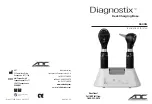
• Connect unit to an electrical outlet. Ensure that the voltage stated on the
rating plate on the bottom of the unit agrees with the mains voltage.
After connection of the charging base, a self-test is performed. During the
test, the LEDs on the front of the unit will be repeatedly switched on.
• When charging 19mm handles
(AA size), insert plastic reducers in
handle recesses. When charging
28mm handles (C size), remove
reducers from handle recesses by
lifting in an upward direction before
inserting handle.
• The ADC Diagnostix Desk Charging Base
may be used for charging 2.5V and 3.5V rechargeable batteries.
The charging chambers are interchangeable and may be used
with 2.5V or 3.5V battery handles. A 2.5V and 3.5V unit may be charged
simultaneously.
b) Charging
• The rechargeable battery is tested when inserted into the charging
chamber. At voltages of less than 1.5V, the rechargeable battery is either
fully discharged or faulty. The charging base will try to recharge the battery
by applying a pulsating charging current. The yellow charging LED will flash.
• For rechargeable battery voltages of more than 1.5V, charging will
commence. The yellow charging LED will turn on.
c) Charging Time
• The end of the charging time is detected
by evaluation of the negative voltage differential
caused by heating of the rechargeable battery
cells when fully charged. The yellow charging
LED will switch off and the green “rechargeable
battery full” LED will switch on.
6
11
Guidance and manufacturer‘s declaration - electromagnetic emissions
The charging station is intended for use in the electromagnetic environment specified below.
The customer of the user of the charging station should ensure that it is used in such an environment.
Emissions testing
RF emissions CISPR 11
RF emissions CISPR 11
Group 1
Class B
Harmonic emissions IEC 61000-3-2
Pass
Voltage fluctuations/flicker emissions
IEC 61000-3-3
Pass
The charging station uses RF energy for its internal function only. Therefore, the RF
emissions are very low and are unlikely to cause interference in nearby electronic
devices.
The charging station is intended for use in all facilities, including residential areas and
those directly connected to a public supply net- work that also supplies buildings
used for residential purposes.
Compliance
Electromagnetic environment guidance


























